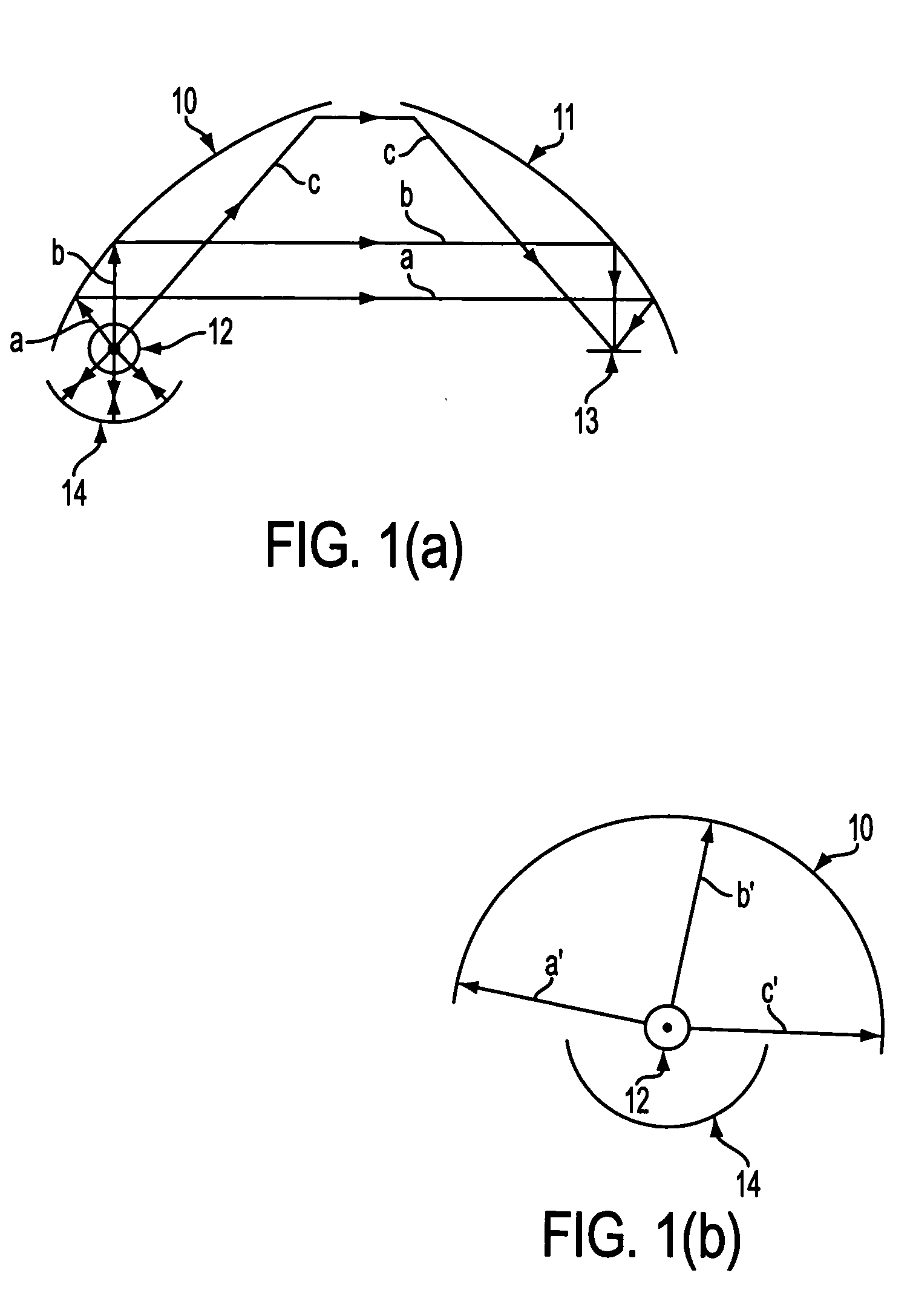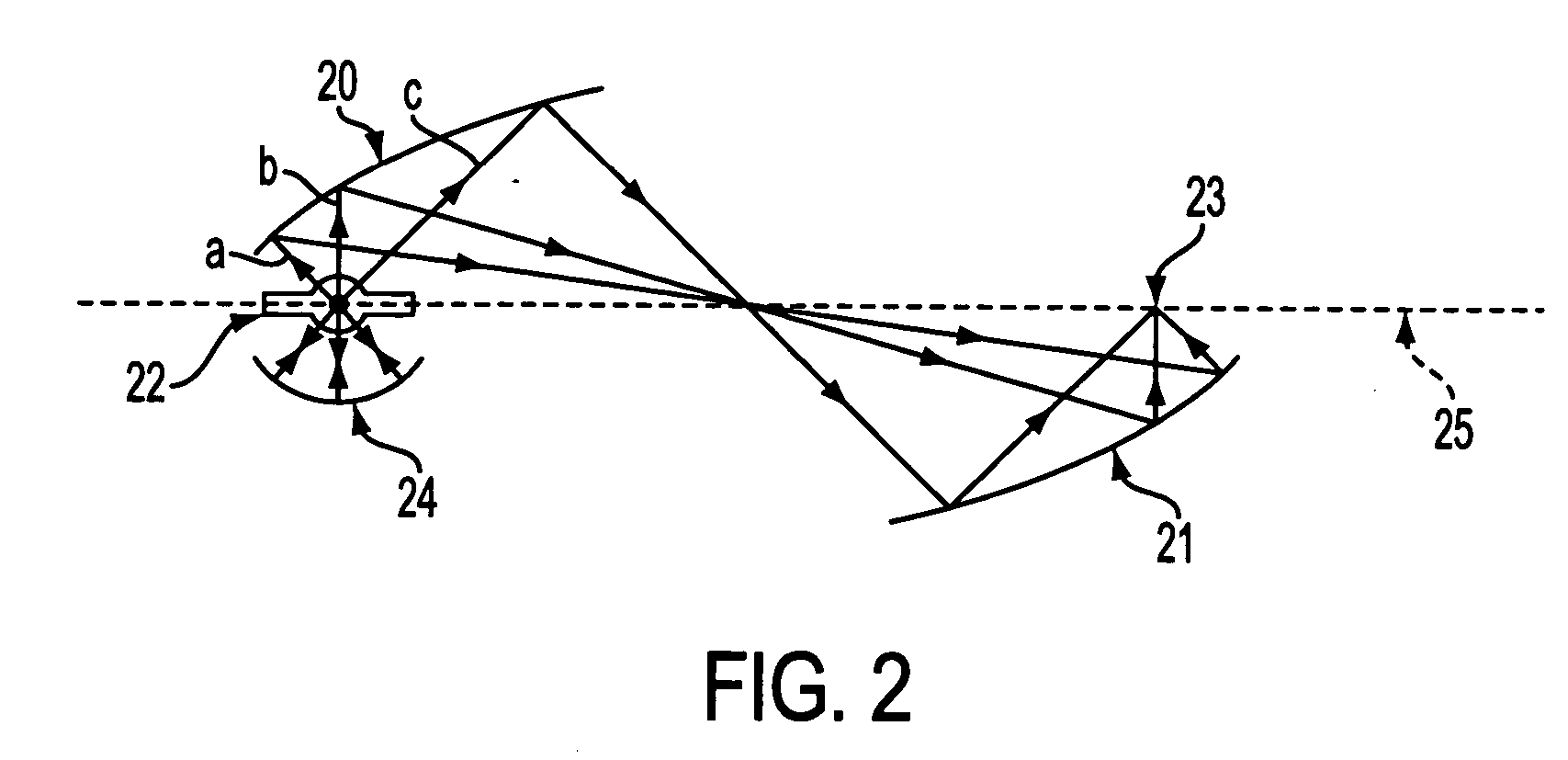Lensed tapered optical waveguide
a tapered optical waveguide and tapered aperture technology, applied in waveguides, instruments, lighting and heating apparatuses, etc., can solve the problems of large numerical aperture combined with small area, unsuitable optical components, and inability to adapt to large numerical apertures
- Summary
- Abstract
- Description
- Claims
- Application Information
AI Technical Summary
Problems solved by technology
Method used
Image
Examples
first embodiment
In a first embodiment, as shown in FIG. 10a, the collecting and condensing system 1000 has a reflector 1008 having a first focal point 1010 and a second focal point 1011 arranged around a source 1006 of electromagnetic radiation 1001 so that source 1006 may be located substantially proximate to first focal point 1010 of reflector 1008. Reflector 1008 may be, e.g. a substantially ellipsoidal, toroidal, spheroidal, or paraboloidal surface of revolution. Source 1006 produces rays of electromagnetic radiation 1001 that are reflected by reflector 1008 toward second focal point 1011, converging substantially at second focal point 1011.
second embodiment
In a second embodiment, as shown in FIG. 10b, reflector 1008 comprises a primary reflector 1008a having a first optical axis 1009a and a first focal point 1010 substantially on the first optical axis 1009a, and a secondary reflector 1008b having a second optical axis 1009b and a second focal point 1011 substantially on the second optical axis 1009b which may be arranged substantially symmetrically to primary reflector 1008a. Primary reflector 1008a may be arranged around source 1006, so that source 1006 may be located substantially proximate to first focal point 1010 of primary reflector 1008a. First optical axis 1009a may be substantially collinear with second optical axis 1009b. Source 1006 produces rays of electromagnetic radiation 1001 that are reflected by primary reflector 1008a toward secondary reflector 1008b, converging substantially at second focal point 1011.
Both of reflectors 1008a and 1008b may be, e.g. substantially ellipsoidal or paraboloidal surfaces of revolution. ...
third embodiment
In a third embodiment, also shown in FIG. 10a, a retro-reflector 1012 may be placed to reflect at least part of that portion of electromagnetic radiation 1001 that does not impinge directly on reflector 1008 back toward reflector 1008 through first focal point 1010 to increase the flux intensity of the converging rays. In a preferred embodiment, additional reflector 1012 may be a spherical retro-reflector disposed on the side of source 1006 opposite reflector 1008 to reflect electromagnetic radiation 1001 emitted from source 1006 in a direction away from reflector 1008 back toward reflector 1008 through first focal point 1010 of reflector 1008.
In one embodiment, source 1006 may be a light-emitting arc lamp. Source 1006 may be, e.g., a xenon lamp, a metal halide lamp, an HID lamp, or a mercury lamp. In an alternative embodiment, source 1006 may be a filament lamp.
PUM
 Login to View More
Login to View More Abstract
Description
Claims
Application Information
 Login to View More
Login to View More - R&D
- Intellectual Property
- Life Sciences
- Materials
- Tech Scout
- Unparalleled Data Quality
- Higher Quality Content
- 60% Fewer Hallucinations
Browse by: Latest US Patents, China's latest patents, Technical Efficacy Thesaurus, Application Domain, Technology Topic, Popular Technical Reports.
© 2025 PatSnap. All rights reserved.Legal|Privacy policy|Modern Slavery Act Transparency Statement|Sitemap|About US| Contact US: help@patsnap.com



